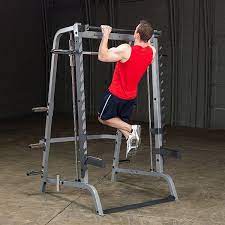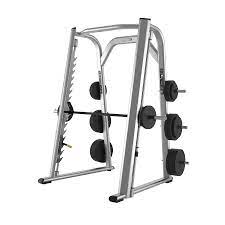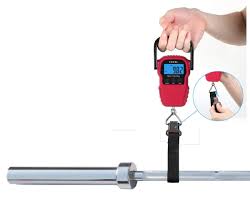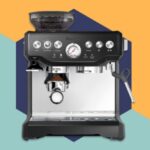If you have a Smith machine in your gym, you’ve probably noticed that the bar isn’t as heavy as a conventional barbell. As a result, it’s difficult to tell how much weight you’re lifting in comparison to other free-weight workouts or equipment.
To make matters worse, most Smith machines lack a sign or sticker indicating the weight of the bar. And measuring it yourself isn’t always easy.
That is why I will respond to the inquiry “how much does a Smith machine bar weigh?” As a result, you no longer have to guess how much resistance you’re applying.

Introduction of A Smith Machine
A Smith machine is a type of weight lifting equipment in which the barbell moves up and down a series of steel rails. The weight is restricted to a vertical (or near-vertical) movement by the guide rails, making it slightly safer than free weights.
Each end of the bar includes a rotating hook and a succession of lockout locations where the weight may be hooked. As a result, the Smith machine can function as a “self-spotting” device, increasing safety.
Smith machines concentrate the force on the key muscles targeted by each exercise by eliminating the need to support the bar. This might be a fun way to change up your routine.
Another advantage of Smith machines is that their starting weight is lower than that of Olympic barbells. However, the exact weight of the bar is determined by a number of factors. So let’s get started with the Smith machine bar weight.
How Much Does The Smith Machine Bar Weigh?
A Smith machine bar can weigh anything from 6 to 32 pounds, depending on the material of manufacture, counterbalancing, and rail angle.
Materials for Bars
Because they are not composed of high-strength steel, some smith machine bars are lighter than a regular 45-pound Olympic bar. With supports on both ends, the bar does not experience the same bending stress as a free-weight bar.
As a result, the bar may weigh 30-40 lbs. Although, because of the additional bearings and hooks, it might occasionally weigh more.
Counterbalancing
Furthermore, Smith machine bars are frequently counterbalanced. This implies that the bar is made lighter by a system of cables, pulleys, and counterweights.
This balancing mechanism is often covered under safety covers, but the image below shows what it looks like on the inside.
The felt weight of a Smith machine bar with a counterweight is generally less than 30 lbs. However, depending on the balancing application, it might be as low as 6 lbs.
But why should the bar be counterbalanced at all? The objective for this is to reduce the initial weight of the bar for persons who are new to training or for workouts that require a smaller load.
So, why not have the bar weigh nothing? If the bar were perfectly balanced with an equal counterweight, the slightest touch would propel it to the machine’s top. As if you were an astronaut in zero gravity!
However, this free-floating bar may cause harm to the machine. As a result, producers of Smith machines rebalance the bar such that it has some weight but not as much as a typical barbell.
Railing Angle
Some Smith machines feature guide rails that are slanted upward. This is done to more closely resemble the natural movement pattern for activities like squats and bench presses. And the angle of the rails might slightly alter the weight of the bar.
You may have created force diagrams like the one below in physics class. This is a basic illustration of the forces at work on an item lying on an incline.
The more inclination there is, the more pulling (or pushing) force is necessary to move the item – in this example, the bar. On a vertical Smith machine, you can feel the entire weight of the bar pulling down.
However, when the angle becomes flatter, the force required to move the item decreases. Consider moving a box over a smooth table. The force needed to push it is far less than the weight of the box.
Because part of the weight is directed into the surface. In this case, the table is holding the majority of the weight, thus pushing the box feels light.
Similarly, a portion of the weight is carried by the slanted Smith machine rails. Although the angle is just 12 degrees from vertical, it is still rather steep. A 30-pound bar seems like 29 pounds when you do the arithmetic. So it’s probably not a big deal to you.

Residential Smith Machines Weight
A residential Smith machine is one you may buy for your home gym. They are often composed of less expensive materials and cost between $1,000 and $2,000.
A regular barbell with a 1′′ diameter, as opposed to the 2′′ diameters of Olympic bars and plates, is commonly used on a home Smith machine. They do, however, sell adapters that allow you to utilize Olympic plates.
Furthermore, the bar is rarely counterbalanced. As a result, despite the fact that the bar is constructed of lighter steel than an Olympic bar, you feel the entire weight. That implies that home Smith machines can start at roughly 30 pounds.
The slide mechanism for the bar on the rails is another popular cost-cutting area. Nylon bushings are occasionally used instead of ball bearings in residential Smith machines. This results in a less smooth movement than a commercial Smith machine.
Commercial Smith Machines Weight
A commercial Smith machine, on the other hand, is one that you might find in a major gym. This is a more expensive piece of equipment that is composed of higher-grade materials and costs between $3,000 and $4,000.
Commercial Smith machines may not necessarily feature Olympic-quality bars, but they do accommodate Olympic plates with a diameter of 2 inches. They normally feature ball bearings and a counterweight to keep the beginning weight to 30 pounds or less.
In my experience, the weight might vary by 5 pounds or more from the specified weight. This is most likely due to machine variance and bearing changes that occur after years of operation.
As a result, if you’re numbers freak like me and want to know precisely how much your Smith machine bar weighs, you may need to measure it!
How To Measure Smith Machine Bar Weight?
A scale or a rope and weight are two methods for determining the weight of a Smith machine bar. I’ll start with the scale technique because it’s the simplest and how I accomplished it.
Also, before you begin, speak with a gym staff to let them know what you’re up to. Don’t be that weirdo who ties ropes to machines or steals restroom scales without permission… With permission, you can be a freak.
Option 1: Scale of Hanging
First, locate a box or other substantial object to use to lift the bar off the machine’s safety stops. Then place a scale on top of the box and lay the bar on it. The weight of the bar will be displayed on the scale’s readout.
If you don’t have a box, place the scale on the floor, walk on it while holding the bar, and note the weight. Then, without the bar, weigh yourself and deduct the result from the initial measurement.
When I performed this test, the scale read 18 pounds. Because this is an older analog scale, I weighed a 20-, 30-, and 40-pound dumbbell to determine whether it was calibrated. Each one was roughly 2 pounds underweight. So the bar is most likely 20 pounds.
The bar should have a starting weight of 25 pounds, according to an equipment provider. As a result, each machine is unique, and wear and tear may cause the resistance of the bar to fluctuate over time.
If you don’t have a scale, you’ll have to go with option 2.
Option No. 2: Rope and Weight
- Look around to make sure no one from the gym is close.
- Remove any plates from the Smith bar.
- Secure the rope around the Smith bar shaft.
- Set the bar to just above your head height and secure it.
- Toss the other end of the rope over the machine’s top. You’ll need around 4 feet of rope sitting on the floor.
- Secure that end of the bar to your heaviest plate. The tied-on plate should be on the floor given the length of the rope.
- Remove the bar.
- Allow the bar to drop low enough to lift the plates off the floor, then gently nudge it up and down to check for the balance. Because the rope creates a lot of friction draped over the frame above you instead of traveling through a pulley, you’ll have to reposition it.
- Return the bar above your head to drop the plates to the floor, then lock it in position.
- Congratulations if it is balanced! If not, repeat steps 5-8 as necessary, adding weight in 2.5lb increments until it is balanced.
You should be able to approximate the weight of the bar within a pound or two using this approach.
Locking the bar in a high position over your head each time will ensure that the counterweight plates you’re tying on sit on the floor and that you don’t risk dropping a plate on your foot while doing this technique.
Read More About Smith Machine:
- Can You Do Deadlift On A Smith Machine?
- How Much Does Bar Weigh on a Smith Machine?
- How To Do A Smith Machine Squat: Benefits, Debate, And Correct Form
- How To Squat On Smith Machine – Safe Or Not? – Kit Machines
Why The Weight Of The Bar Is Important
To be sure, that’s a lot of work for determining the weight of a Smith machine bar. So, why is it important in the first place?
For one thing, it allows you to make more precise percentage-based modifications to the weight you lift week after week. This is an essential component of any gradual overload strategy.
Knowing the actual weight of the bar is also helpful in estimating your beginning weight for a comparable free-weight workout. If you regularly bench press 135 pounds, you might want to add a 10-pound plate on each side for the Smith machine bench press.
Keep in mind that this is not always a perfect comparison because the Smith machine’s route targets various muscles.
Comparing it to Freeweight Olympic Bars
Remember that a normal 7-foot Olympic bar at the gym weighs 45 pounds, and many individuals begin with that weight, or more, for most exercises.
A woman’s Olympic lifting bar weighs 35 or 33 pounds (15 kg).
There are also lightweight Olympic bars. Some 5ft or 6ft bars are intended to provide a beginning weight of as little as 25 lbs, which is extremely beneficial considering that some ladies or children cannot bench press the empty 45lb bar, to begin with.
Athletes training the clean-and-jerk or snatch utilize 10lb aluminum training bars, whereas 5lb hollow steel bars are used for group cardio training courses and mild fitness training.
For weight training, however, as is done on a Smith machine, 15 lbs is a reasonable starting weight.

Takeaways Tips of Smith Machine Bar Weight Key
- Smith machine bars typically weigh 15-25 lbs.
- Smith machine bars that are counterbalanced may weigh less than 15 pounds.
- The weight of the bar is unaffected by the angle of the Smith machine.
- Each machine is unique, and wear and tear might affect the resistance of the bar.
- To acquire an exact measurement, weigh the bar on the machine with a scale.
Conclusion
You should have a better notion of how much weight you’re lifting now that I’ve addressed the question “how much does a Smith machine bar weigh?”
While a few pounds difference won’t make or break your fitness results, individuals who pay attention to the nuances tend to acquire results faster.
So, if you want extensive solutions to your fitness issues, have a look at some of my other relevant posts below.











